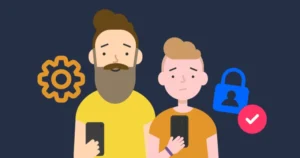How to prevent child identity theft
Tips and advice to protect your child’s privacy online
From setting parental controls to reviewing the data that sites collect from your child, there are things you can do to prevent identity theft happening to your child. Explore expert guidance below to help your child stay safe from potential identity theft.
 Close video
Close video
Quick tips
2 ways to prevent child identity theft
Many parents, carers and teachers tell children to keep personal information private. However, not all children understand what that means.
So, to help prevent identity theft and data breaches, show them what personal information is. Personal information includes:
- Full names
- Where they live
- Contact information such as email and phone numbers
- Photos of themselves
- Passwords or information in their passwords.
You can help children learn more about their privacy with interactive activities from Digital Matters.
Cyber security is the safety and privacy settings on your family’s devices. Good cyber security can prevent identity theft in online spaces.
You can improve your family’s cyber security in the following ways.
Teach children how to think critically about the information they see online. This will help them identify and deal with misinformation that can lead to scams or cyber attacks.
- Review your anti-virus software, or install some if you haven’t done it yet. There are free options available
- Set complex and secure passwords for all accounts
- Set up parental controls across devices, apps and games. These can limit who can contact your child and can also require passwords for spending
What’s on this page
- What is personal information?
- What is identity theft?
- Who is really a friend?
- Practical ways to prevent identity theft
How to talk about privacy with children
Research shows that conversations about online issues are key to keeping kids safe online.
What is personal information?
Explain to children what personal information is in terms the can understand. You can do this by giving examples. Personal information includes:
- Names: their full name, names of their friends or family members and name of their school. If they use a pet name as a part of their passwords, then they shouldn’t share that pet’s name either.
- Contact details: their/others’ email, mobile number and home address. This also includes sharing such information in online forms.
- Identifying images: themselves in front of a home or school, themselves in their school uniform or other clothes that are a part of a club or organisation.
Help children understand that sharing such information makes it easy for cyber criminals to steal their identity or data.
What is identity theft?
Even if children understand what personal information is, they might not fully grasp online identity theft. However, in 2022, nearly 1 million US children were victims of identity theft, showing the importance of teaching kids about it.
If someone steals a child’s identity, they might:
- Open and max out credit cards in the child’s name. This can have long-term impacts on their credit score, which will affect how easy they can make purchases and manage their finances in the future.
- Open bank accounts for scam purposes.
- Get loans or apply for benefits in the child’s name.
Who is really a friend?
Children and young people who use social media networks or apps like WhatsApp might have hundreds or even thousands of contacts or ‘friends’. But how many of these people do they actually know?
Unfortunately, many children judge success by the number of subscribers or followers they have. So, they might not think all that carefully about adding new people or keeping profiles public.
Therefore, it’s important to talk to children about what an online friend actually is and why it’s important to add new contacts with care.
Explore our Expert Q+A on online friendships to get support.
Practical ways to prevent identity theft
You can prevent identity theft from happening to your child by taking practical steps to protect them.
Review device security
Check that location services are turned off and that your child doesn’t have any unknown contacts saved. Additionally, ensure they have the latest version of their device’s operating system installed so their security is up-to-date.
Use private and incognito browsers
Encourage your child to use private or incognito browsers when they use public devices. They can also use these browsers when they need to access sensitive information like banking details.
See what is already public
Search your child’s full name in several search engines to see what information and photographs are public. You can then contact the sites or server providers to remove that information.
Review privacy settings
With your child, review the privacy settings on the apps and sites they use. You might also want to set their accounts to private to limit who can see what they post.
Remove old apps and accounts
Together with your child, review old apps and accounts and help them delete or remove any that they no longer use. Cyber criminals are then unable to access old data, limiting incidents of identity theft or other cyber attacks.
Create secure passwords
Teach children how to create secure passwords by using random words and characters. They should also keep that information private from even friends.
Featured online identity theft articles
 Research
Research
What does the Online Safety Act mean for you and your child?
The Policy and Research team at Internet Matters shares what the Online Safety Act means for parents and children.
 Q&A
Q&A
How do cookies and algorithms impact children’s privacy online?
Experts share advice around managing cookies, algorithms and consent to help keep children safe online.
 Research
Research
Age assurance and online safety: What parents and children have to say
Ahead of the publication of Ofcom’s Children’s Safety Codes, our recent tracker survey asks children and parents what they think about age assurance.
 Parent stories
Parent stories
How one family embraces Instagram Teen Accounts
Mum of two, Zoe, shares her experience of Instagram teen accounts.
How to best use location tracking apps within your family
Location tracking apps via smartphones are a common way to keep track of your child outside of the home.

